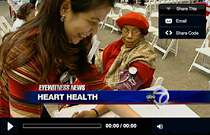ARTICLES, PUBLICATIONS and VIDEOS
|
|
RWJUH and New Brunswick Cardiology Group Electrophysiologist Dr. Stroh Interview Re: Tim Russert’s Sudden Death
|
Wear Red Day Draws Attention
- view on WABC website |
Published Articles |
|
|
Serial Assessment of Coronary Flow Reserve by Rubidium-82
Positron Emission Tomography Predicts Mortality in Heart
Transplant Recipients. Authors: Feher A, Srivastava A, Quail MA, Boutagy NE, Khanna P, Wilson L, Miller EJ, Liu YH, Lee F, Sinusas AJ. Publication: JACC Cardiovasc Imaging. 2018 Oct 12. pii: S1936-878X(18)30755-1. DOI: 10.1016/j.jcmg.2018.08.025. [Epub ahead of print] Includes Free Article PMID: 30343093 |
Benefits & risks of statin therapy for primary prevention of
cardiovascular disease in Asian Indians - a population with
the highest risk of premature coronary artery disease &
diabetes. Authors: Enas EA, Kuruvila A, Khanna P, Pitchumoni CS, Mohan V. Publication: Indian J Med Res. 2013 Oct;138(4):461-91. Review. Includes Free PMC Article PMID: 24434254 |
|
Recovery of left ventricular function after percutaneous
revascularization of a left main chronic total occlusion. Authors: Khanna P, Stilp E, Pfau S. Publication: Catheter Cardiovasc Interv. 2012 Aug 1;80(2):310-5. DOI: 10.1002/ccd.24322. Epub 2012 May 2. PMID: 22553190 |
Cardiac FDG-PET to assess sarcoidosis in a cardiac
allograft. |
|
|
|
| Robert Wood Johnson University Hospital: What Makes a Hospital an Academic Medical Center? | |
|
Robert Wood Johnson University Hospital |
|
|
View the video about our office technology. |
|
|
RWJUH Medical Minutes: Atrial Fibrillation (Irregular Heartbeat) with Subhashini Gowda, MD |
|
|
Cardiovascular Disease HealthTalk featuring Subhashini
Gowda, MD and Robert A. Panebianco, MD |
|
|
Subhashini Gowda, MD, Cardiac Electrophysiologist |
|
|
Magnetic Navigation Treatment for Heart Arrhythmias 
Last fall, Ron Dunham found himself in the Emergency
Department at Robert Wood Johnson University Hospital (RWJUH),
where shock paddles were waiting, wondering “What am I doing
here?” He was in good health, except that his heart
sometimes felt like it was racing. There wasn’t any pain and
it would come and go, so he paid little attention. |
|
| Back to Top | |
